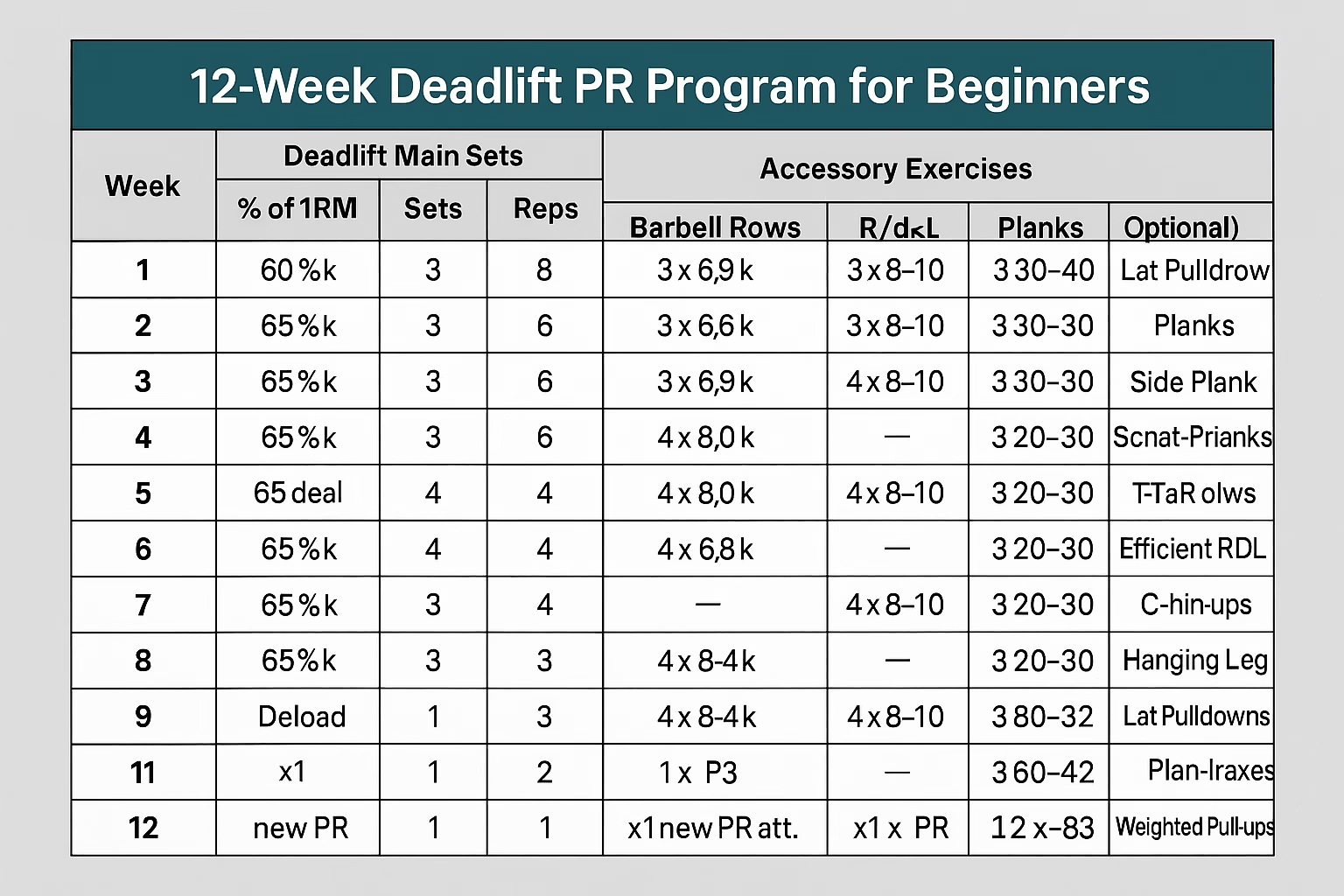12-Week Deadlift Program: Beginner’s guide for PR
This is a comprehensive 12-week periodized deadlift program designed to systematically build strength and culminate in a new personal record (PR). The program uses percentage-based training that automatically calculates your working weights based on your current 1-rep max (1RM).
How to Set Up the Program
Step 1: Enter Your Current 1RM
- Open the “Start Here” sheet
- Enter your current deadlift 1RM in kilograms in cell B1
- The program automatically converts this to pounds in cell B2 using the formula
B1*2.20462 - Important: All percentage calculations are based on this initial input
Step 2: Understanding the Automatic Calculations
- Each week’s working weight is automatically calculated using formulas
- For example, Week 1 uses 60% of your 1RM:
'Start Here'!B1*0.6 - Weights are displayed in both kg and lbs on each weekly sheet
- You don’t need to manually calculate any weights
Program Structure & Periodization
Phase 1: Base Building (Weeks 1-3)
Objective: Build volume tolerance and technical proficiency
- Week 1: 60% × 3 sets × 5 reps
- Week 2: 65% × 3 sets × 5 reps
- Week 3: 70% × 3 sets × 5 reps
Focus: Higher rep ranges with moderate intensity to establish movement patterns and build work capacity.
Phase 2: Deload (Week 4)
Objective: Recovery and adaptation
- Week 4: 55% × 2 sets × 5 reps
Purpose: Allows your body to recover and adapt to the previous three weeks of training while maintaining movement quality.
Phase 3: Strength Development (Weeks 5-7)
Objective: Build strength endurance
- Week 5: 72.5% × 4 sets × 4 reps
- Week 6: 75% × 4 sets × 4 reps
- Week 7: 77.5% × 4 sets × 4 reps
Focus: Increased training volume with moderate-high intensity to develop strength endurance.
Phase 4: Active Recovery (Week 8)
Objective: Preparation for final strength phase
- Week 8: 60% × 3 sets × 5 reps
Purpose: Strategic deload before the final high-intensity phase.
Phase 5: Peak Strength (Weeks 9-12)
Objective: Neural adaptation and strength maximization
- Week 9: 80% × 3 sets × 3 reps
- Week 10: 85% × 3 sets × 3 reps
- Week 11: 90% × 2 sets × 2 reps
- Week 12: 95% × 1 set × 1 rep
Focus: Progressive intensity increase with reduced volume to peak for a new 1RM attempt.
Accessory Work Program
Consistent Throughout All 12 Weeks:
- Barbell Rows: 3 sets × 10-12 reps
- Purpose: Strengthen posterior chain and improve posture
- Execution: Focus on pulling to lower chest/upper abdomen
- Romanian Deadlifts (RDLs): 3 sets × 8-10 reps
- Purpose: Hip hinge pattern reinforcement and hamstring development
- Weight: Use 40-60% of your deadlift 1RM
- Planks: 3 sets × 30-60 seconds
- Purpose: Core stability and anterior chain strengthening
- Progression: Start at 30 seconds, work toward 60 seconds
- Lat Pulldown/Pull-ups: 3 sets × 8-12 reps
- Purpose: Lat strength for improved deadlift lockout
- Option: Choose based on your strength level
How to Use the Program Effectively
Weekly Training Schedule
- Frequency: Perform this workout 1-2 times per week
- Spacing: If training twice weekly, space sessions 72+ hours apart
- Integration: This can be part of a larger training program
Warm-Up Protocol
Before each session:
- 5-10 minutes general warm-up (light cardio)
- Dynamic stretching focusing on hips and hamstrings
- Deadlift warm-up sets:
- Empty bar × 5-10 reps
- 50% of working weight × 3-5 reps
- 75% of working weight × 2-3 reps
- 90% of working weight × 1 rep
Progressive Overload Strategy
- Weeks 1-8: Focus on perfect technique and completion of prescribed reps
- Weeks 9-12: Maintain strict form while handling maximal loads
- Beyond Week 12: Test new 1RM and restart program with updated numbers
Weight Selection Tips
- Round weights: Round calculated weights to nearest 2.5kg/5lbs
- Fractional plates: Consider using fractional plates (0.5kg/1.25lb) for precise loading in final weeks
- Safety first: If a weight feels too heavy on a particular day, reduce by 5-10%
Program Modifications
For Beginners
- Add an extra week to each phase
- Consider using 90-95% of true 1RM as program 1RM
- Focus heavily on form over load
For Advanced Lifters
- Add pause deadlifts or deficit deadlifts as variations
- Increase accessory work volume by 1-2 additional sets
- Consider block pulls or rack pulls in final weeks
For Those Without 1RM
If you don’t know your 1RM:
- Use a rep max calculator with a recent 3-5RM
- Perform a controlled 1RM test before starting
- Estimate conservatively – you can always adjust
Success Tips
Technical Focus Points
- Setup: Consistent foot position, hip-width apart
- Grip: Mixed or double overhand, hands just outside legs
- Breathing: Big breath at top, hold through lift, exhale at lockout
- Bar path: Straight line, stays close to body throughout
Recovery Considerations
- Sleep: 7-9 hours per night for optimal adaptation
- Nutrition: Adequate protein (1g per lb bodyweight) and calories
- Hydration: Proper fluid intake, especially on training days
- Stress management: High stress can impact strength gains
When to Adjust the Program
- Missed reps: If you miss reps two sessions in a row, reduce intensity by 5%
- Excessive fatigue: Consider an extra deload week
- Life stress: Reduce intensity during high-stress periods
- Plateau: After completing program, take 1 week complete rest before retesting
Expected Outcomes
Realistic Strength Gains
- Beginners: 15-30lb (7-14kg) increase in 1RM
- Intermediate: 10-20lb (4.5-9kg) increase in 1RM
- Advanced: 5-15lb (2-7kg) increase in 1RM
Additional Benefits
- Improved deadlift technique and consistency
- Enhanced posterior chain strength
- Better core stability and overall strength
- Increased confidence under heavy loads
Troubleshooting Common Issues
“The weights feel too light early on”
- This is intentional – resist the urge to add weight
- Focus on perfect technique and speed of execution
- Trust the process – intensity increases significantly
“I’m struggling with the higher percentages”
- Ensure adequate warm-up and preparation
- Check your initial 1RM wasn’t overestimated
- Consider if external factors (sleep, stress, nutrition) are impacting performance
“I want to add more exercises”
- The accessory work is sufficient for most people
- If adding exercises, prioritize posterior chain and core work
- Don’t compromise the main deadlift sessions
Post-Program Protocol
Week 13: Testing Week
- Rest 2-3 days after final workout
- Perform proper warm-up protocol
- Attempt new 1RM following your usual competition timing
- Record result for next program cycle
Continuing Progress
- Use new 1RM to restart the program
- Consider taking 1 week complete rest between cycles
- Track long-term progress over multiple cycles
This program’s strength lies in its systematic approach, automatic weight calculations, and proven periodization model. Success comes from consistency, patience, and trusting the process even when early weeks feel too easy.
FAQs
Q: Should I use my true 1RM or a training max?
A: For beginners, consider using 90-95% of your true 1RM as your program 1RM. This provides a safety margin and ensures you can complete all prescribed reps with good form.
Q: Do I need access to fractional plates?
A: While not essential for most of the program, fractional plates (0.5kg/1.25lb) become valuable in weeks 9-12 when precise loading matters more. If unavailable, round to the nearest 2.5kg/5lbs.
Q: How often should I deadlift during this program?
A: Perform the deadlift workout 1-2 times per week. If training twice weekly, space sessions at least 72 hours apart to allow for proper recovery.
Q: Can I do other exercises on deadlift days?
A: Yes, but prioritize the deadlift session. The included accessory work (barbell rows, RDLs, planks, lat pulldowns/pull-ups) is designed to complement the main lifts. Avoid excessive additional volume that could interfere with recovery.
Q: How should I warm up before each session?
A: Follow this protocol:
1. 5-10 minutes general warm-up (light cardio)
2. Dynamic stretching for hips and hamstrings
3. Deadlift-specific warm-up: Empty bar × 5-10 reps
– 50% working weight × 3-5 reps
– 75% working weight × 2-3 reps
– 90% working weight × 1 rep



